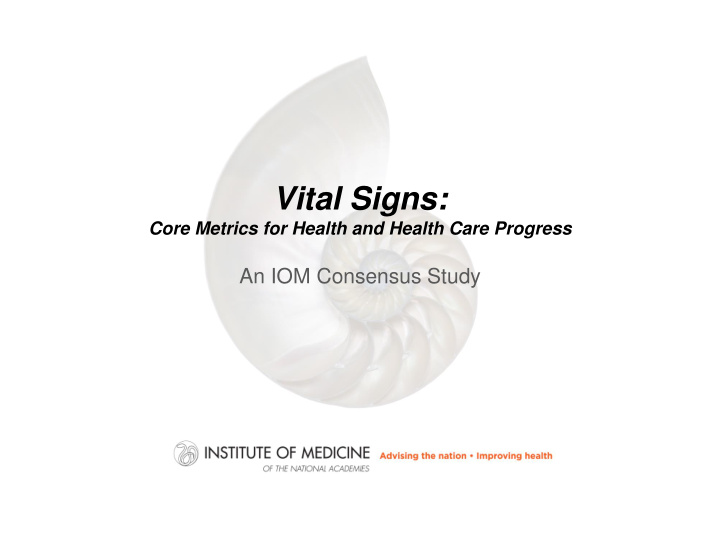



Vital Signs: Core Metrics for Health and Health Care Progress An IOM Consensus Study
2
Topics • Committee • Study motivations • Committee charge • Core metrics benefits • Core metrics characteristics • Challenges • 15 recommended core measures • Stakeholder roles 3
Committee on Core Metrics for Better Health at Lower Cost DAVID BLUMENTHAL (Chair),The Commonwealth Fund JULIE BYNUM, The Dartmouth Institute LORI COYNER, Oregon Health Authority DIANA DOOLEY , California Health and Human Services TIMOTHY FERRIS, Partners HealthCare SHERRY GLIED, New York University LARRY GREEN, University of Colorado at Denver GEORGE ISHAM, HealthPartners CRAIG JONES, Vermont Blueprint for Health ROBERT KOCHER, Venrock KEVIN LARSEN, Office of the National Coordinator for HIT ELIZABETH McGLYNN, Kaiser Permanente ELIZABETH MITCHELL, Network for Regional Health Improvement SALLY OKUN, PatientsLikeMe LYN PAGET, Health Policy Partners KYU RHEE, IBM Corporation DANA GELB SAFRAN, Blue Cross Blue Shield of Massachusetts LEWIS SANDY, UnitedHealth Group DAVID STEVENS, National Association of Community Health Centers PAUL TANG , Palo Alto Medical Foundation STEVEN TEUTSCH, Los Angeles County Department of Public Health 4
Study motivations • Measure proliferation is independent of priority • Requirements are often inconsistent • Measures themselves are often inconsistent • Data collected inconsistently have limited usefulness • Clinician burden (time/$) is growing rapidly • Process focus tends to fragment actions • Fragmented measures obscure system performance 5
Committee Charge An ad hoc committee will conduct a study and prepare a report directed at exploring measurement of individual and population health outcomes and costs, identifying fragilities and gaps in available systems, and considering approaches and priorities for developing the measures necessary for a continuously learning and improving health system. The Committee will: consider candidate measures suggested as reliable and representative reflections of health status, care quality, people’s engagement and experience, and care costs for individuals and populations; identify current reporting requirements related to progress in health status, health care access and quality, people’s engagement and experience, costs of health care, and public health; identify data systems currently used to monitor progress on these parameters at national, state, local, organizational, and individual levels; establish criteria to guide the development and selection of the measures most important to guide current and future-oriented action; propose a basic, minimum slate of core metrics for use as sentinel indices of performance at various levels with respect to the key elements of health and health care progress: people’s engagement and experience, quality, cost, and health; indicate how these core indices should relate to, inform, and enhance the development, use, and reporting on more detailed measures tailored to various specific conditions and circumstances; identify needs, opportunities, and priorities for developing and maintaining the measurement capacity necessary for optimal use of the proposed core metrics; and recommend an approach and governance options for continuously refining and improving the relevance and utility of the metrics over time and at all levels. 6
` 7
Core metrics benefits • Sharpen focus on the actionable issues most broadly important to improving people’s health • Counter the natural tendency to focus on separate pieces at the expense of system performance • Drive relationships and integration across levels and activities • Provide key standardized reference points for tailored measurement activities of specialized interest 8
Core metrics characteristics • Reliably reflect health, care quality, and cost • Parsimonious • Standardized — simplify and facilitate comparison • Multi-level: national, state, local, institutional • Multi-stakeholder: shared accountability for health • Publicly led • Cooperatively stewarded 9
Challenges • Finding the most important measures • Relating core performance to the rest • Buffering special interests, tendency to expand • Reflecting the whole, in a way that captures the parts • Agreement on standardization • Stakeholder uptake and use • Leadership and stewardship that is sustained 10
11
12
(dozens — examples ) 13
Stakeholder roles • Clinicians: reduced burden through streamlined and standardized measures that register results and performance that matter most. • Payers and employers: ability to anchor reporting requirements on results most important to the health of a covered population, and compare provider performance in a standardized, meaningful way. • Communities: raise awareness of priorities and develop collaborative multisectoral strategies for tracking and improving health. • Public health: forge population health partnerships with health care organizations and shared accountability for outcomes. • Voluntaries: pilot the use of core metrics by integrating measurement activities and developing performance dashboards. • Measure developers: produce and pilot composite measures through multistakeholder collaboration, and work with HHS on implementation. 14
HHS Leadership 15
Recommend
More recommend